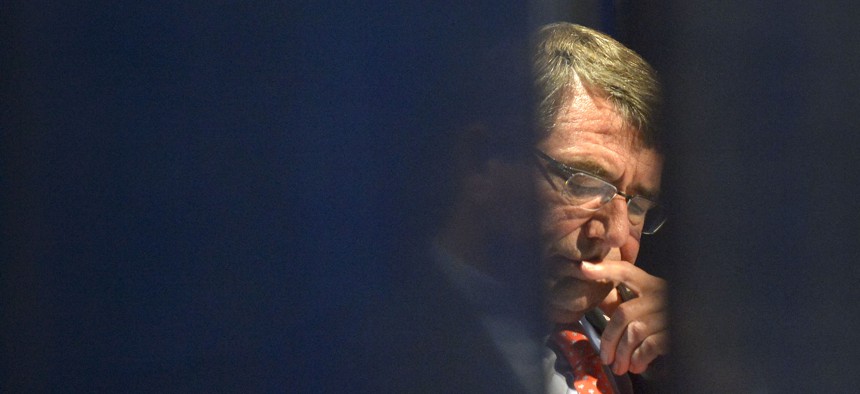
Defense Secretary Ash Carter backstage before addressing the American Legion Convention, in Baltimore, Md., Sept. 1, 2015. DoD Photo by Glenn Fawcett
Ash Who? After Six Months On The Job, 44% Have No Opinion on Defense Secretary
A Defense One survey finds that nearly half of troops, natsec employees say they still have no opinion about Ash Carter.
Defense Secretary Ash Carter registered a lowly 38 percent approval rating in a new poll of U.S. troops, Defense Department civilians, and other national security personnel. Perhaps more revealingly, a larger chunk — 44 percent — said that more than six months into his term, they still have no opinion of their new boss.
It’s a stark revelation and a potentially complicating factor for Carter, who frequently says he has less than two years to make an impact as Pentagon chief, assuming his term lasts until the end of the Obama administration. At the end of his first quarter of play, the secretary has made few waves in Washington, which has been obsessed this year with the Iran nuclear deal, President Obama’s fight (or lack of fight) against the Islamic State, and the 2016 presidential campaign. The budget, an area Carter was expected to master, has yet to come to a head on Capitol Hill, and could change Carter’s Q-rating.
To date, Carter has invested his public persona mostly in the extensive travel typical of the job. He has visited bases and installations across the United States, most particularly the new one in Silicon Valley, where Carter has continued his high-priority mission to connect the Defense Department to America’s tech industry. And he has traveled extensively overseas, to Afghanistan, Iraq, Europe, and Asia. As he goes, he always carves out time to meet with troops in small groups or holding larger “troop talks” where he makes a short speech and opens the floor to any questions brave service members may wish to ask.
But appearances outside of Washington barely register within the Beltway or with workaday federal employees and servicemembers. Carter’s public image has not overcome what some see as a stumbling start out of the gate, and it has not been helped by the loss of some of the most experienced and senior public affairs talent in the Defense Department.
Upon taking office, Carter fired the Pentagon’s top spokesman, former Navy Rear Adm. John Kirby, one of the military’s most familiar and revered mouthpieces. (Secretary of State John Kerry quickly picked Kirby up and put him at the podium in Foggy Bottom.) Then he left the job vacant for months. Meanwhile, Assistant Secretary of Defense Brent Colburn left his post after just 17 months, replaced by Maura Sullivan, former spokeswoman for the Department of Veterans Affairs. In addition, Col. Steve Warren, the top officer running the Pentagon’s core medial relations shop, the Office of Secretary of Defense Public Affairs, or OSDPA, was cycled out.
None of this has helped him warm up the Pentagon press corps. Since February, Carter has held just four full press conferences in the Pentagon briefing room.
The good news for Carter is that his numbers are improving. In May, less than three months after Carter took office, a Defense One poll found just 24 percent approved of him, 11 percent disapproved, and 65 said they did not have an opinion. Previous polls have revealed that the national security workforce is not shy about voicing a thumbs-up or -down for their boss. Former Defense Secretary Chuck Hagel turned in a 26 percent approval rating in November, with 35 percent disapproving and 39 percent saying they had no opinion. In an April poll by Defense News, Hagel registered 36 approval to 45 percent disapproval, with less than 19 percent saying they had no opinion.
And as Carter’s first year progresses, he may have opportunities to move the needle on his approval rating. On Wednesday, the secretary’s public affairs staff announced what they billed as his first worldwide troop talk. Military personnel were invited to submit questions via social media for the secretary to answer from a live interview in Maryland. He gave them one hour.
The survey was conducted by Defense One and Government Business Council, the research division of Government Executive Media Group, between August 20-27. The survey was emailed to a random sample of Defense One, Government Executive and Nextgov subscribers. There were 465 respondents from the Departments of Defense, Homeland Security, State, and the military service branches. Of that total, 15 percent were active duty military and 7 percent were military reservists. Fifty-eight percent of respondents are at least GS/GM-13, or military equivalent. The margin of error is +/-3.29 percent.




